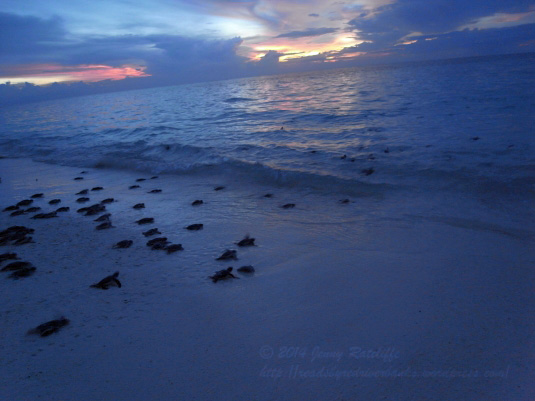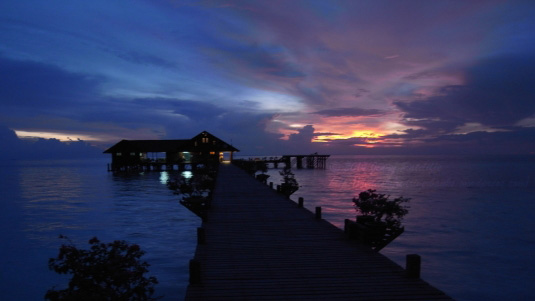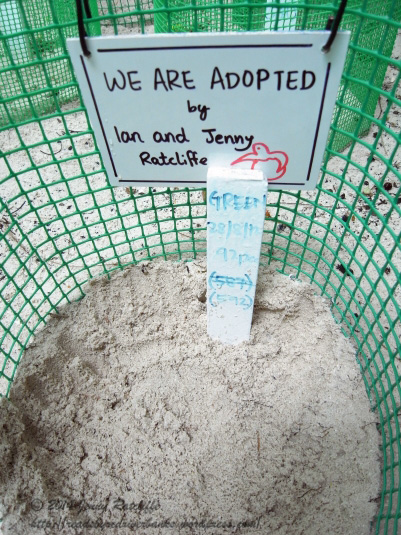As the sunset flared and the night sky darken around us, I watched these little guys head off for the big wide watery world out there. R.E.M.’s hauntingly melodic Night Swimming was the inevitable soundtrack in my head.
Lankayan island, a tiny Malaysian gem way out in the blue waters of the Sulu Sea, is in what is known as the Turtle Corridor. It is part of a wider Marine Protected Area, and is a much-needed haven for large numbers of nesting Green and Hawksbill turtles.
The island has a small eco-resort and a marine conservation and monitoring station, run by Reef Guardian. One element of their awareness raising work is providing guests to the island the opportunity to ‘adopt’ a nest of turtle eggs. Of course we were more than happy to part with a little bit of our holiday money to become turtle parents. Even better that it meant we could put some money into turtle conservation efforts along the way!
For those hatchlings bravely hurtling towards the sea, the odds aren’t stacked in their favour, even after the protection afforded to them on Lankayan during their incubation and hatching. Predation by big fish and sharks is the first major obstacle for these little ones. But if they make it past that hurdle, then human factors come into play. Risk from plastic suffocation and drowning caused by entanglement in abandoned fishing lines and nets, potential by-catch on long-line fishing trawlers, illness and death caused by chemical and oil pollution, as well as injury and fatalities caused by boat strikes. It’s a long and depressing list of the heavy toll we place on the seas, and sadly not unique to sea turtles by any means.
Hawksbill turtles don’t reach sexual maturity until around twelve years old, Green turtles are older, at more than twenty years old. So given the threats they face, it’s no wonder that sea turtle populations worldwide are so vulnerable. That is an awfully long time to dodge all those risks and make it to the point of contributing to the long-term survival of their species.
So that’s my entry for this week’s WordPress photo challenge; nighttime. Let’s hope that this wave of hatchlings had a quiet night for their first encounter with the sea and night swimming, and that some of them at least get the chance to grow to adulthood. And to finish on a lighter note:
It’s awesome, Jellyman. Little dudes are just eggs, we leave ’em on the beach to hatch, and then — koo-koo ka-choo! — they find their way back to the Big Ol’ Blue.
Crush the turtle (Pixar’s Finding Nemo of course!)




What great turtle parents!
LikeLike
Thanks Tish! We loved them, albeit briefly! ;o)
LikeLiked by 1 person
What gorgeous nighttime shots and a great post!–Patti
LikeLiked by 1 person
Thanks so much Patti, very kind of you. :o)
LikeLike
great photos and even greater memories – thank you for sharing with us.. have a wonderful day.
LikeLike
Thank you very much for stopping by and commenting, Clay. I appreciate your kind comments. You have a good day too!
LikeLike
That’s amazing experience Jenny, and it’s sweet of you to adopt the turtles for conservation purposes. Well informative post!
LikeLiked by 1 person
Thank you, you are so kind! Yes, it was a really amazing experience, we felt very privileged to be able to do it. And the diving there was incredible too, so we got all the luck that holiday! :o)
LikeLike
Great subject well captured. Love your adoption sign 🙂 we have a similar turtle program on Kiawah for leatherback. The little ones are so adorable and so vulnerable when the leave the nest, usually about an hour before dawn. We have a turtle patrol that tracks every nest. It’s fascinating isn’t it?
LikeLiked by 1 person
Thanks Tina! We had to have a little memento of our turtle babies! :o) It is an amazing thing to witness the hatching and return to the sea. I didn’t know about the Kiawah one, that is great. At least having such turtle conservation efforts in place does something positive to help. They are such amazing creatures.
LikeLike
Oh wow! You don’t need the BBC when you’re out seeing this first hand! What a privilege and yes, I wouldn’t have hesitated to “adopt” some turtles. Such precious creatures. I love the photos too. Great composition to get the adult turtles heading back to sea and that gorgeous sky on the horizon 🙂
LikeLike
Thank you Sarah – your comments on my photos are a massive compliment! :o) We have had some amazing wildlife moments, and we have definitely been blessed…although it is always good to have the BBC as a background resource for the boring stay-at-home weeks!! :o)
LikeLike
Oh, I know what you mean!! Every intimate wildlife encounter that I have feels like an extraordinary blessing. There are many parts of the world that I can’t visit because of my Crohn’s and the meds I have to take so the BBC compensates for that, along with all the wonderful photos and stories I get to see on WordPress 🙂
LikeLike
The limits on travel because of your Crohn’s must be so frustrating at times. But as your photographs so beautifully show, there is wildlife in such abundance in Britain. Yes, there are some amazing bloggers out there for satisfying my need for wildlife and wild landscapes. I can easily spend hours reading about their experiences and wondering at the stunning photographs!
LikeLike
LOVE this post and pics!
LikeLike
Thank you very much! Sea turtles are a favourite of mine, so I’m glad to share with people who appreciate them to! :o)
LikeLiked by 1 person
I’ve never seen the hatchlings heading for the water. So cool, Jenny! Nice shots.
LikeLike
Seriously cool, Cathy! Thank you – I loved watching it! Hope you get the chance some day, it is an amazing thing to experience.
LikeLike
Pingback: Photo Challenge: Nighttime | tnkerr-Writing Prompts and Practice
Amazing… 😀
LikeLike
Thank you! :o)
LikeLike
What a great thing to do; become turtle parents. Thank you for the interesting post and great night-time photos.
LikeLike
Thank you! It felt like a real privilege to get the chance.
LikeLike
Wonderful images!
LikeLike
Thank you so much. It was such an exciting moment.
LikeLike
I sat up half the night once watching a soft shell turtle lay eggs in my front garden. I was waiting for her to finish so I could cover them with a metal cage. Around 2 am I fell asleep. When I woke at dawn something had already gotten the eggs. Sea turtles have an even harder time. Nice photo blog entry.
LikeLiked by 1 person
Thank you! What a thing to witness – fantastic! It’s sad that you didn’t manage to safeguard the nest, but I guess that is the circle of life. I can cope with that far more easily than all the man-made risks turtles and sea turtles face.
LikeLike